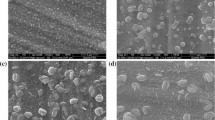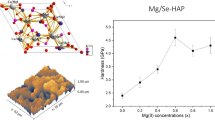Abstract
Highly ordered TiO2 nano-pillar arrays were deposited on the Ti foils by a hydrothermal method, using aqueous solutions of TiOSO4. The vertical nano-pillars with diameters in tens of nanometers strongly attached on the Ti foil and densely covered the whole surface. The structural studies clearly showed that the nano-pillars were pure tetragonal rutile TiO2 phase. [001] was the preferential growth direction. Based on the experimental results, a model for the in situ deposition of TiO2 with high-energy facet exposed is given. The growth mechanism was interpreted in terms of the lattice matching between the growing nano-structural titania and Ti, and the thermodynamic stability of the rutile lattice planes. The obtained TiO2 crystallographic plane with high energy induced apatite nucleation in less than 1 day and exhibited good in vitro bioactivity.











Similar content being viewed by others
References
Suchanek K, Hajdyla M, Maximenko A, Zarzycki A, Marszalek M, Jany BR, Krok F (2017) The influence of nanoporous anodic titanium oxide substrates on the growth of the crystalline hydroxyapatite coatings. Mater Chem Phys 186:167–178
Siu HT, Man HC (2013) Fabrication of bioactive titania coating on nitinol by plasma electrolytic oxidation. Appl Surf Sci 274:181–187
Kim HL, Park IS, Lee SJ, Yu MK, Lee KW, Bae TS, Lee MH (2014) Effect of surface pretreatment and pack cementation on bioactivity of titanium dental implant. Surf Coat Technol 259:178–184
Pereira BL, Tummler P, Marino CB, Soares PC, Kuromoto NK (2014) Titanium bioactivity surfaces obtained by chemical/electrochemical treatments. Materia-Brazil 19:16–23
Kim S, Kim Y, Park I, Jin G, Bae T, Lee M (2014) Effect of alkali and heat treatments for bioactivity of TiO2 nanotubes. Appl Surf Sci 321:412–419
Wang XH, Gao Y, Yang L, Liu ZX (2011) Bioactivity study of the titanium plates treated with microarc oxidation and alkali. J Nanosci Nanotechnol 11:9650–9655
Gao L, Feng B, Wang JX, Lu X, Liu DL, Qu SX, Weng J (2009) Micro/nanostructural porous surface on titanium and bioactivity. J Biomed Mater Res B 89B:335–341
Han Y, Chen DH, Sun JF, Zhang YM, Xu KW (2008) UV-enhanced bioactivity and cell response of micro-arc oxidized titania coatings. Acta Mater 4:1518–1529
Uchida M, Kim H, Kokubo T, Fujibayashi S, Nakamura T (2003) Structural dependence of apatite formation on titania gels in a simulated body fluid. J Biomed Mater Res 64A:164–170
Lindberg F, Heinrichs J, Ericson F, Thomsen P, Engqvist H (2008) Hydroxylapatite growth on single-crystal rutile substrates. Biomaterials 29:3317–3323
Yang GJ, Li CJ, Wang YY, Li CX (2008) Origin of preferential orientation of rutile phase in thermally sprayed TiO2 coatings. Mater Lett 62:1670–1672
Kasemanankul P, Witit-Anan N, Chaiyakun S, Limsuwan P, Boonamnuayvitaya V (2009) Low-temperature deposition of (110) and (101) rutile TiO2 thin films using dual cathode DC unbalanced magnetron sputtering for inducing hydroxyapatite. Mater Chem Phys 117:288–293
Cui X, Kim HM, Kawashita M, Wang L, Xiong T, Kokubo T, Nakamura T (2009) Preparation of bioactive titania films on titanium metal via anodic oxidation. Dent Mater 25:80–86
Tang K, Tao H, Jiang X (2012) Possible reaction between titanium (IV) and hydrogen peroxide in acidic condition: an ab initio study on its mechanism. Acta Chim Sinica 70:2091–2096
Li T, Tian B, Zhang J, Dong R, Wang T, Yang F (2013) Facile tailoring of anatase TiO2 morphology by use of H2O2: from microflowers with dominant 101 facets to microspheres with exposed 001 facets. Ind Eng Chem Res 52:6704–6712
Murray JL, Wriedt HA (1987) The O − Ti (oxygen–titanium) system. J Phase Equilib 8:148–165
Wang Y, Zhang L, Deng K, Chen X, Zou Z (2007) Low temperature synthesis and photocatalytic activity of rutile TiO2 nanorod superstructures. J Phys Chem C 111:2709–2714
He G, Xie L, Yin GF et al (2013) Synthesis and mechanism of (101)-preferred orientation rutile titania via anodic spark oxidation. Surf Coat Technol 228:201–208
Morgan BJ, Watson GW (2009) A density functional theory + U study of oxygen vacancy formation at the (110), (100), (101), and (001) surfaces of rutile TiO2. J Phys Chem C 113:7322–7328
Liao MY, Fang L, Xu CL, Wu F, Huang QL, Saleem M (2014) Effect of seed layer on the growth of rutile TiO2 nanorod arrays and their performance in dye-sensitized solar cells. Mater Sci Semicond Process 24:1–8
Deskins NA, Kerisit S, Rosso KM, Dupuis M (2007) Molecular dynamics characterization of rutile-anatase interfaces. J Phys Chem C 111:9290–9298
Wang WK, Chen JJ, Zhang X, Huang YX, Li WW, Yu HQ (2016) Self-induced synthesis of phase junction TiO2 with a tailored rutile to anatase ratio below phase transition temperature. Sci Rep 6:20491/1–20491/10
Hu W, Li L, Tong W, Li G (2010) Supersaturated spontaneous nucleation to TiO2 microspheres: synthesis and giant dielectric performance. Chem Commun 46:3113–3115
Wu JM, Hayakawa S, Tsuru K, Osaka A (2004) Low-temperature preparation of anatase and rutile layers on titanium substrates and their ability to induce in vitro apatite deposition. J Am Ceram Soc 87:1635–1642
Yang B, Uchida M, Kim HM, Zhang X, Kokubo T (2004) Preparation of bioactive titanium metal via anodic oxidation treatment. Biomaterials 25:1003–1010
Acknowledgements
This work was supported by National Natural Science Foundation of China (50702050), the Natural Science Foundation of Zhejiang Province, China (LY15E020010), and Okayama University, Japan.
Author information
Authors and Affiliations
Corresponding author
Rights and permissions
About this article
Cite this article
Xiao, F., Jiang, GQ., Chen, JY. et al. Apatite-forming ability of hydrothermally deposited rutile nano-structural arrays with exposed {101} facets on Ti foil. J Mater Sci 53, 285–294 (2018). https://doi.org/10.1007/s10853-017-1513-8
Received:
Accepted:
Published:
Issue Date:
DOI: https://doi.org/10.1007/s10853-017-1513-8




